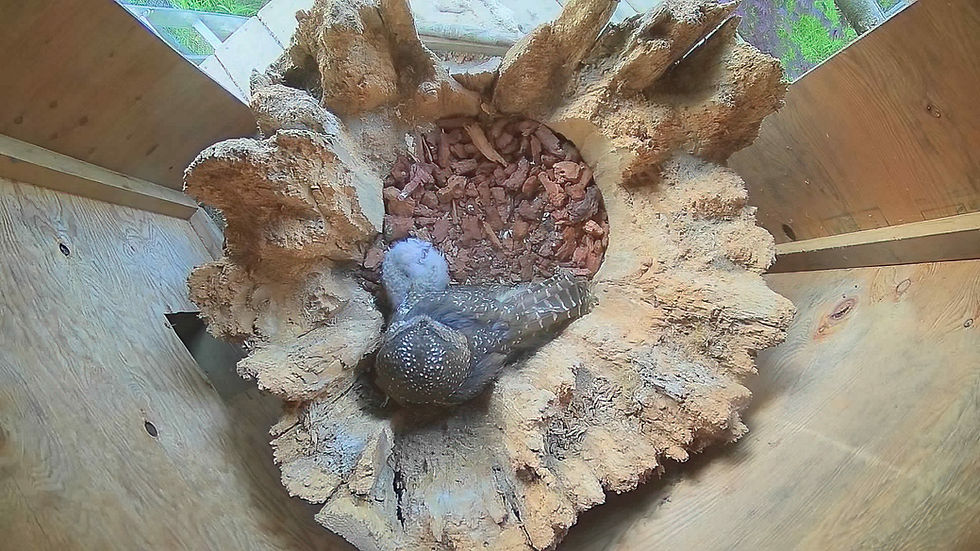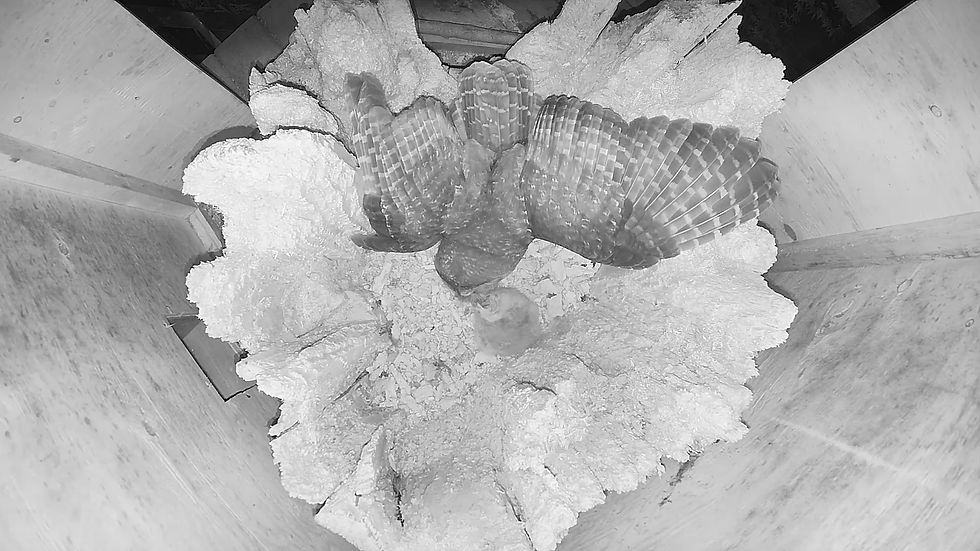The Secret Lives of Spotted Owls
- Oct 10, 2023
- 3 min read
Updated: Oct 19, 2023

If an owl jumps into its nest stump in the middle of the night, does it make a sound?
At the Northern Spotted Owl Breeding Program, the owls live in large aviaries where they can breed without the pressures and threats that the species faces in the wild. Each aviary has at least two cameras, including one that focuses exclusively on the nest stump.
Our team spends hours upon hours reviewing nighttime footage of the owls to track breeding patterns that indicate whether an owl is getting ready to start a family. We focus on identifying different behaviours based on the specific owl pairs and the time of year.
Strengthening a bond
Chasing and nest interest are very important for unbonded pairs early on in the breeding season. As time passes, we begin to see prey delivery. The male will fly to the female and land beside her. The two look at each other, their behaviours mirroring those of previous generations of spotted owls. As the male inches closer to his mate with food in his beak, he promises to provide for their future family with a 4-note call, and the female accepts.
Out of all the behaviours we see, copulation is the most important because it cements the bond between owls. There's a small window of time where copulation must happen that coincides with when the female is forming an egg inside her body. For eggs to be fertilized and develop into chicks, the timing has to work out.
Each owl is different. Some pairs are quick to start breeding. A few have specific branches where they frequently copulate; others will do so anywhere at any time of night. The interactions we monitor help us predict when eggs will arrive and highlight the delicate balance in each pair’s reproduction journeys.
Nurturing new life
When a female spotted owl lays an egg, she sits on it for 32 days until it hatches. However, at the Northern Spotted Owl Breeding Program, staff artificially incubate the eggs to give each egg the best chance at hatching successfully.
After females lay, our monitoring focuses on ensuring the female continues her natural behaviours and maintains her connection with her future chick by keeping a dummy egg warm.
Female spotted owls hardly leave the nest, doing so only to poop and give their mate a chance to continue copulating with her. During this time, she primarily relies on her mate for food. We have seen females with incredible internal clocks that leave two times per night at the same time every night. A few are incredibly devoted and won't get off their nest for days at a time.
With silent flight and around 9,000 feathers that make up most of their size, spotted owls are incredibly lightweight and agile when returning to the nest. Some carefully hop into the furthest corner away from their eggs, landing with a small thud. Others use their wings to brace themselves, slowly and delicately climbing in.

Caring for chicks
Once chicks arrive, the male's role continues to complement the female's as they work in harmony to provide food and care. Our team monitors families to ensure the chicks grow and eat well. Most males deliver food a handful of times each day, but one male at the breeding centre brought food for his family 15 times in one night!
A female can take over 30 minutes to feed her chick bit by bit, multiple times per day. As a chick develops, it can handle larger food pieces and starts to thermoregulate, so the female adjusts her feeding and nest time to match the chick’s evolving needs.
Our cameras also record many behaviours that go beyond the major pillars of breeding. One day, we observed a female returning to the nest to find a massive chick poop right in the middle of it. She used her beak, typically reserved for tearing up rodents, to maneuver the sliver of cedar with the feces to the edge of the nest and flip it over. In the wild, other bird species often dispose of poop in similar ways, but nest conditions and a lack of predators make it unusual for spotted owls. While we can’t generalize the behaviour of one owl at the breeding centre, all the monitoring we do really highlights the uniqueness and importance of each owl.
As we strive to conserve and protect this endangered species, our understanding of their behaviours remains vital to increasing their numbers. We are incredibly grateful to have insight into the intimacy between owls and their family dynamics.
This article was originally published in our 2023 Newsletter.








